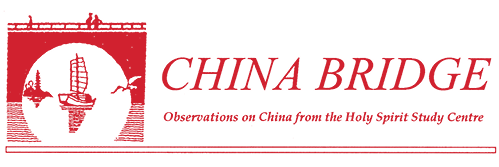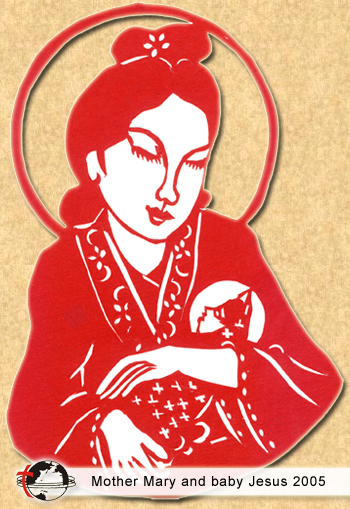
China Bridge (神州橋樑)_2005/Dec
Why in heaven did Jesus come to earth?

A decade ago, a parish in Hong Kong sent several young adults to visit a Catholic village in the mountains west of the Pearl River Delta. They left the bright lights and smog of the city and enjoyed clean air and blue sky in the countryside. Little did they suspect how dark the night sky would be. Electric lights were few and far between in Chinese villages back then. After a meal and animated conversation, they left the house, stepped outside, and saw countless stars for the first time in their lives. Some of them panicked. “What is up there? How little we are!” They felt overwhelmed, lost in an immense universe.
Yet shepherds guarding their flocks by night felt at home under the old familiar stars and the Magi saw a new star as a sign of a wonderful birth, a summons to saddle up their camels for a marvellous adventure.
The good news of Christmas is that God has bridged the gap between heaven and earth. “The mountains are high and the emperor is far away,” was an old Chinese saying. The emperor was awesome and mighty, for sure, as anyone who rebelled against his tax collectors soon learned, but the Son of Heaven mostly stayed in a distant palace. He occasionally sent a notice to all of China’s 2,000-plus counties. The county magistrate then visited several towns on their market days, summoned the crowd to silence, and read the printed decree. Then everyone kowtowed. Later a clerk filed the document in a side office in the yamen, (衙門) and life went on as before. Those closer to the centre of power saw the emperor with their own eyes. They had a saying, “Ten thousand people know the emperor, but the emperor does not know ten thousand people.” Even today many people believe that there is a God on the other side of the universe, a distant autocrat, unapproachable and unaware of their existence as individual human beings – cold comfort at any time of the year.
But the Good News of Christmas is that “the Word was made flesh and dwelt among us” (John 1:14). The second person of the Blessed Trinity was born of the Virgin Mary as a flesh and blood Jewish baby boy. Why would God do such a thing?
The Catechism of the Catholic Church (Par. 456-460) lists five reasons for the Incarnation.
The Word was made flesh for our salvation. The Latin greeting “Salve!” (Two syllables) was a wish meaning “Good health to you!” It survives as the English word salve, (one syllable), a healing cream.
Jesus, the divine physician, healed many sick people. In recent years, many Chinese, especially those who cannot afford western medicine or a stay in a hospital, have prayed to Jesus and have been cured. Often a neighbor encouraged them to pray: “Pray to Jesus. You will be healed. And he will not even demand a chicken or a duck in return!” Many who asked with faith have discovered the healing power of Jesus, both physical and emotional. Jesus does not expect an animal sacrifice in return, as in Chinese folk religion.
Admittedly, spiritual healing goes deeper than a medical cure, but bodily healing draws attention and has led to many conversions. Sophisticated city people smile at such stories, but those with advanced education are a minority.
Jesus came to reconcile us with God. All is not right with our world. Both the damaged natural environment and our interpersonal, interethnic, and international relationships are in a mess. The wisest human efforts to undo the harm only succeed partway. Our hearts never seem to find rest and peace. St. Augustine said, “You have made us for yourself alone, oh God, and our hearts will never rest until they rest in you.” So God who created our hearts took the initiative and sent his only son into the world. Because Jesus’ mission had a happy ending – the resurrection – it is right for us to rejoice in the birth of the Prince of Peace. That reconciliation overflowed into the non-human world. Even sheep and barn animals were part of the Christmas scene.
In China, people, especially Daoists, have always loved being at peace with the natural world. Chinese landscape paintings show a few small human beings, plus buildings and sometimes fields, all blending into the big picture. From their Confucian heritage, Chinese cultivate right relations with family and friends. As the late Pope John Paul II said repeatedly, “There is no contradiction between being truly Christian and authentically Chinese.” By bringing Jesus into the picture, Chinese Catholics find reconciliation with God and so they are better able to contribute to a harmonious society. In this 21st century, domestic and international harmony, not to mention harmony with the ecology, are life-and-death issues across the globe.
Jesus came so that we might experience God’s love. It is one thing to read about love, another to feel loved by someone special. A rigorously argued, abstract presentation on the goodness of God, the potential of human nature and the working of divine providence within history will not move anybody to tears of joy or songs of praise. However, everybody can relate to a flesh and blood baby. Across the centuries, in every nation, people are captivated by a baby. A Hindu poet, Rabindranath Tagore, (1861-1941) wrote, “Every time a baby is born, it is a sign that God still has hope for the world.” One, and only one time in human history, a baby, specifically a Jewish baby boy, Son of Mary and also Son of God, was born. Baby Jesus brought more love and more hope into the world than did any other baby. This is Good News for all nations.
As early as the first half of the 17th century, missionaries in China and their converts were printing woodcuts to depict the birth in Bethlehem with Chinese background, figures with Chinese faces and wearing Chinese clothing and backgrounded by Chinese buildings. Yet something odd happened in the second half of the 20th century: the more the government told the Christians that they were Chinese first and believers second, the more they preferred holy cards, paintings and statues in European style. It was a way for Catholics especially to remind themselves that their religion was bigger than China. Religious art can be subversive, so during the Cultural Revolution (1966-1976) the Red Guards burned or smashed the artwork of every religion. Today, Chinese Catholics and Protestants are again creating religious art with Chinese characteristics. In time, they will arrive at their own styles, both “truly Christian and authentically Chinese.”
Jesus came as a model of holiness. The highest compliment paid to the semi-mythical rulers who founded Chinese civilization was that they were sheng, (聖) “a sage” or “holy.” Confucius, the Teacher for Ten Thousand Generations, was also sheng, and a good part of the training of the classical scholar concerned self-cultivation to become a sage, admittedly an ideal that was seldom realized. Early Jesuit missionaries sought points of contact with the Chinese tradition and presented Jesus as the fullness of holiness. China today is once again proud of its long tradition and is presenting it to a new generation, aiming to fill a spiritual vacuum with Confucian ideals.
Jesus came to make us partakers of the divine nature. The Son of God became a baby so that babies can one day become adopted sons and daughters of God. In the second century, St. Irenaeus wrote, “The glory of God is a human fully alive.” Jesus came that we might have more abundant life (John 10:10). This new life continues into eternity. Beyond anything we can achieve by our own efforts at self-improvement or moral cultivation, Jesus offers the gift of life forever in heaven.
People have always been searching for eternal life. Ancient Chinese noted the dark areas on the full moon and saw a rabbit holding a pestle pounding away at a mortar to grind and mix the medicine of immortality. Around the time of Christ, several Chinese ships sailed east in search of the medicine of eternal life. Daoist boiled, melted and blended different substances to change lead into gold and to find the medicine of youth. A few died of poisoning, but others laid the groundwork for the science of chemistry. “Chemistry” was the first Chinese word to enter the English language. It comes from alchemy, Arabic al-chem, which came from the Chinese word for gold, jin (金).
The quest for gold and for long life has preoccupied people throughout the ages. While wealth and life expectancy have increased in the past 2,000 years, the human race is still no closer to living forever. Eternal life is God’s gift to us. The divine plan is to uplift us and give us unending joy, starting on earth and reaching fulfillment in heaven. In a world that measures everything by gold and judges people on their youthful appearance, this is good news indeed. The poor, the rich, the old, the young, the sick, the healthy, the happy and the broken-hearted are all welcome to kneel before the newborn king and worship. Come, let us adore him, Christ the Lord!
Merry Christmas!
MJS


 ENG
ENG